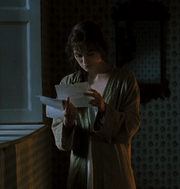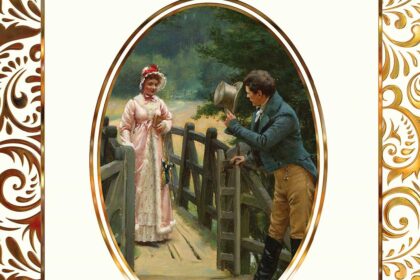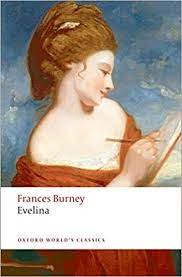The sharing of books is the primary love language among the women in my family. My grandmother rarely hugs me, and yet, every Christmas I receive a cardboard box with a selection of beaten up, perfectly loved paperback beauties carefully curated for me. I receive one from my mother too, though this collection is in a whole foods bag, not in a box, and often features hardbacks as well. I give them to my mother and grandmother in return. These have been facts of my life for the past decade. They have been the primary love I have given and the primary love I have received. And it has been entirely enough. The love exchanged in my maternal lineage is not verbal or physical – it is literary. Text is how we understand one another, how we love one another, and how we communicate with one another. Few understand the power material texts hold in fostering and communicating love, but Elizabeth Bennet and Mr. Darcy surely do.
In Jane Austen’s Pride and Prejudice, the major emotional shifts in either of the protagonists consistently occur within the presence of an aesthetic text1- whether it be poetry, music, carefully crafted letters, or visual art. As such, the courtship of Elizabeth by Mr. Darcy relies explicitly on material objects, as it provides the two with an avenue in which they see one another, understand one another, and eventually come to love one another in a way that is inaccessible to them in spoken communication. As is consistently demonstrated in Pride and Prejudice, text is the love language of Elizabeth and Mr. Darcy.
The story begins where all great love stories do – in the complete and utter absence of love. When Jane becomes ill at Netherfield and Elizabeth quickly rushes to her side, the beginning of Elizabeth’s time therein is entirely devoid of romantic interest for Darcy, and the lack of interest is reciprocated. They disagree on women’s education, Elizabeth thinks him pretentious and prideful, and Darcy thinks her beneath him and merely tolerable. At this point in Pride and Prejudice, our two protagonists have both no avenue through which to understand one another and no desire to do so. And yet precisely when it seems that there is no path forward, a brief discussion of poetry occurs, and with it a brief moment of understanding. When Mrs. Bennett visits Jane at Netherfield, she begins boasting of Jane’s desirability to Mr. Bingley in stating that a previous suitor had written her verses. “‘And so ended his affection,’ said Elizabeth … ‘I wonder who first discovered the efficacy of poetry in driving away love!’” writes Austen, showcasing that Elizabeth already understands poetry’s power to kill love (Austen 74). The reverse, it seems, is already known to Darcy, as he rebuttals that he has “been used to consider poetry as the food of love” (Austen 74). Though they occupy opposite sides of this binary in the spoken communication, the two begin to understand essential aspects of the other’s mode of being through this conversation. Darcy, on one hand, reveals that he views material art forms to be a safe space in which to express the authentic emotion that renders him verbally uncomfortable. Additionally, Elizabeth reveals that she is quite particular about the aesthetic qualities of text, as bad poetry can kill love. In this scene, it becomes abundantly clear that both
1 In this paper, I am defining text as any work which can be “read” by our characters – music, visual art, poetry, and of course, letters.
Elizabeth and Mr. Darcy recognize the value of good art, thereby instilling within art the power to bring them together.
Mr. Darcy allows himself honesty in letters that he does not allow himself in verbal communication. The next scene reveals this explicitly as a major emotional shift occurs in Mr. Darcy whilst composing a letter to his sister, Georgiana. A conversation at Netherfield among Mr. Darcy, Elizabeth, and the Bingley siblings occurs in which Elizabeth begins to regard Mr. Darcy’s written words as art. Mr. Darcy’s writing process is detailed as Ms. Bingley asks if he “always writes such charming long letters to her,” highlighting that Darcy puts great thought into his letters (Austen 76). His writing is further described as being written in even lines, and Mr. Bingley even states that he does “not write with ease,” again clueing both the reader and Elizabeth into Darcy’s letter writing as laborious art-making (Austen 76). Elizabeth, in this scene, learns to value the efforts of Darcy’s writing, illustrated by her encouragement to finish his letter. The presence of this aesthetic text sparks a visual connection between the two, and they begin watching each other as Elizabeth moves to the piano. “Elizabeth could not help observing as she turned over some music books that lay on the instrument, how frequently Mr. Darcy’s eyes were fixed on her,” writes Austen, showing us their attempts to see one another with the letter as a catalyst (Austen 79). Additionally, the mere presence of a letter being created places Darcy in a contemplative, self-reflective, and more honest mental landscape, as aesthetic text is his realm of comfort. Due to this letter being present, Darcy realizes not only that Elizabeth has fine eyes, but also that he “had never been so bewitched by any woman as he was by her” (Austen 79). This scene in Pride and Prejudice both characterizes Mr. Darcy as a textual artist and reinforces the power of material art in the novel to elicit emotional realizations in the protagonists.
A scene that has been extensively critically read, and yet is essential to the argument of the textual love language between Mr. Darcy and Elizabeth, occurs as Elizabeth plays the pianoforte at Rosings. Again, for the sake of this paper, I am defining music to be within the categorization of aesthetic text, and the presence of music at Rosings allows for a moment of emotional intimacy between Mr. Darcy and Elizabeth. After some banter regarding Mr. Darcy’s lack of dancing at the ball, Mr. Darcy admits to his social anxieties. “I am ill qualified to recommend myself to strangers,” he tells Elizabeth, constituting the most vulnerable verbal communication the reader has yet seen from Mr. Darcy (Austen 175). With the presence of music continually in the landscape of the scene, he continues in describing himself as not having “the talent which some people possess of conversing easily with those I have never seen before,” further revealing himself to Elizabeth (Austen 176). Elizabeth then describes an anecdote of her failures at piano being attributed to her lack of practice, attempting to chastise Darcy for his lack of practise in socialization. And herein, with the music forever sounding, comes the first moment of mutual connection, mutual understanding, and mutual seeing between our protagonists.“We neither of us perform to strangers,” declares Darcy, implying an understanding between the two that has occurred while in the textual presence of music and while discussing music. Though the reader is not given access to Elizabeth’s reaction to this exclamation, it is clear that this is a
crucial moment of intimacy, honesty, and understanding between the protagonists initiated by the musical background. Text allows Darcy to surrender his emotional armor.
For all of volume one and most of volume two, the reader watches Mr. Darcy and Elizabeth watch each other, though their eyes never seem to meet. When Elizabeth receives the infamous letter from Mr. Darcy, their eyes meet for the first time on this piece of textual art. Austen’s writing style is notoriously non-descriptive, as we scarcely receive descriptions of physical spaces or objects. Mr. Darcy’s letter is the exception, for Austen pays careful time and attention to detailing the physicality of this letter thereby reinforcing its importance in the text. Elizabeth “perceived an envelope containing two sheets of letter paper, written quite through, in a very close hand,” Austen writes, reinforcing the letter’s presence as material text (Austen 190). In comparison with the first proposal scene, where verbal dialogue is forgone in favor of focalizing the scene through Elizabeth’s perception, Darcy’s words dominate the dialogue through his letter thereby allowing Elizabeth to see Darcy through an unfiltered lens. After reading this carefully crafted letter, Elizabeth experiences a profound emotional shift in becoming both aware of her own errors and acquitting Mr. Darcy of his. She studies the letter extensively, and Austen writes that “Mr Darcy’s letter, she was in a fair way of soon knowing by heart” (Austen 203). As Elizabeth distinguishes Mr. Darcy’s letters as art, she comes to understand Mr. Darcy through this letter in a way that verbal communication never offered. Though in the previous examples Mr. Darcy becomes vulnerable through the presence of material text, Elizabeth’s reading of his letter constitutes Elizabeth’s first experience authentically seeing Mr. Darcy, despite the fact that he is not physically present. Material text, at this point in Pride and Prejudice, has transformed both protagonists by offering them an avenue through which to understand one another.
The transformation of Elizabeth by material text is completed upon her visit to Pemberley as she strolls through the portrait gallery. Elizabeth had been previously described by Mr. Bingley as a “studier of character,” and in viewing Mr. Darcy’s portrait, this description is revealed to be quite apt (Austen 72). While viewing his likeness on the canvas, Elizabeth contemplates the contents of his character in an ekphrastic moment in which the art comes alive through the power of her gaze. “As she stood before the canvas, on which he was represented, and fixed his eyes upon herself, she thought of his regard with a deeper sentiment of gratitude than it had ever raised before; she remembered its warmth, and softened its impropriety of expression,” writes Austen, illustrating that this portrait allows Elizabeth to understand, see, and even begin to love Mr. Darcy (Austen 231). Elizabeth, at this moment in Pride and Prejudice, has not physically seen him since before receiving his letter, and the portrait provides a mechanism through which their eyes meet once again. Additionally, just as she became obsessed with the words of Mr. Darcy’s letter, she becomes “arrested” by this portrait, returning to it twice and taking a final glance upon leaving the room (Austen 231). While viewing this portrait, Elizabeth studies the character of Mr. Darcy, and she determines that she may quite like the contents. She reads the portrait in the same way that she reads his words, and the two
experiences have much the same effect. Material text again allows Elizabeth to see, understand, and eventually begin to love Mr. Darcy in a way that verbal communication does not offer.
Mr. Darcy asserts himself to be incapable of and uncomfortable with recommending himself to strangers. Elizabeth was a stranger at the outset of Pride and Prejudice. And yet, by its completion, we receive two protagonists who fully see, understand, and love one another. How does this transformation occur in such a relatively short spanse of time, most of which the two are not physically together? The courtship of Elizabeth and Mr. Darcy is entirely reliant on material text, be it discussions of poetry, letters, music, or visual art. Mr. Darcy may be ill qualified to recommend himself to strangers, but material texts make him comfortable with doing so. Elizabeth is a studier of character, and material texts provide her with a character to study. Through these texts, Mr. Darcy comfortably reveals the contents of his character, and Elizabeth is provided with a mechanism through which to study him. Without the continual presence of aesthetic text, Elizabeth and Mr. Darcy would have no avenue through which to understand one another. Just as my ability to give and receive love in certain relationships relies on sharing texts, Jane Austen in Pride and Prejudice crafts two protagonists whose love is entirely dependent on artistic text. Text, then, is the love language of Mr. and Mrs. Darcy.




